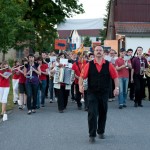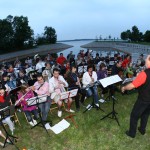After the mining industry
On the road
“Zampern” is an old Sorbian tradition in many of the villages in Lausitz, which takes place as part of Carnival. Celebrations today take place before Lent (compare Mardi Gras, or Pancake Tuesday…) but has evolved from pre-Christian traditions. Masks and costumes, loud noise and music are to frighten off ghosts, evil spirits and demons, and winter is driven off to make way for spring. Zampern is then also an ideal metaphor for the relinquishment of the past and the turning to the future…
Looking ahead
In 2008 Schlabendorf became part of the town of Luckau. Under the new administration the name of Schlabendorf was again destined to be wiped from the map. To prevent this from happening, the locals got together and decided to change every single streetname in the village to “Schlabendorf am See” (Schlabendorf on Sea: “See” is german for lake). Now, the address of every inhabitant makes it abundantly clear that the new lake has opened new perspectives.
When the coalmining came to a halt and the area was flooded, a new harbour was built at the edge of the lake. In 2005 the Water Sport Association of Schlabendorf was founded, and now boats sail across the old mining territory. By 2012 the water should be back to its normal, higher level.
Sielmanns Nature Reserve, Wanninchen
The 40m-deep minesaround Schlabendorf produced browncoal from 1959 to 1991. Heinz Sielmann established his nature reserve at the edge of the former mine, now the banks of the new Schlabendorf lake. The mines had threatened the existence of much of the wildlife and fauna, but thanks to the Sielmann Nature reserve, most species are returning to the area.



